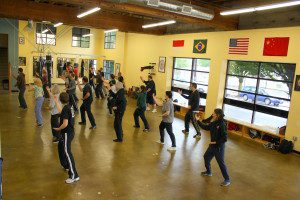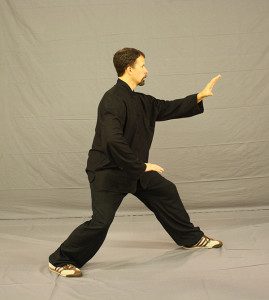 This guideon How To Do Tai Chi For Beginners is broken into three parts The How, The Why and Going Deeper. The how only takes a couple of minutes and will change your life. Do it now. Once you’ve had that experience move on the to why and going deeper. Each will add to the power of the practice. If you want to read it all right now, of course go ahead. However, “Opera Non Verba” deeds not words. Understanding a problem doesn’t solve it. No matter how hard we look at the hole in the boat that is our life, we’re still going to sink unless we get to work.
This guideon How To Do Tai Chi For Beginners is broken into three parts The How, The Why and Going Deeper. The how only takes a couple of minutes and will change your life. Do it now. Once you’ve had that experience move on the to why and going deeper. Each will add to the power of the practice. If you want to read it all right now, of course go ahead. However, “Opera Non Verba” deeds not words. Understanding a problem doesn’t solve it. No matter how hard we look at the hole in the boat that is our life, we’re still going to sink unless we get to work.
How To Do Tai Chi For Beginners: The How
Step One, Get present, Get energized.
Your breathing is broken. Feel your next breath. Now breathe in as much air as you possibly can. That unused range of your breath is a life changer. No exaggeration you’re about to improve your relationships, your work, your health, your happiness.
Shallow breathing is a sign of being in a reactive state. You can learn more about that in The Why, but for now just know it’s bad and let’s fix it.
Ten stretching breaths: Each inhale take in as much as you can until you feel some stretch and strain in the chest, back and abdomen. Exhale by relaxing only, the breath flows out gently on it’s own. Next breath take in a little bit more, a little bit more and so on.
Ride the wave: If you can, close your eyes and then breath in this deeper state for the next 1-2 minutes. Go ahead and do longer if you like. Listen to your body as you breathe and relax any tension you find.
That’s it! Just a few minutes and you’ve moved from a reactive/stagnant state and are in a more aware and present state.
Another beginning breath-work option:
Step Two, Get Free
Your body in movement can feel supple and powerful, like flowing water.
The main issue here is stagnation, we don’t move enough and in enough different ways.
Work through the body, smoothly circling the joints on every angle they can move.
- Start in the fingers
- Move to the wrists
- Elbows – move each joint on every angle it can, smoothly – no forcing anything
- Shoulders
- Neck – Rotations and rolls
- Spine – Twists that engage every joint, waves that work each joint
- Hips – Circles and openers
- Knees – Circles, do without weight in the leg if you have any knee injuries
- Ankles- Circles
- Feet – Roll ups to stretch the feet and work the toes
Put your awareness in the joint as you are working. Move smoothly and follow any tension you find through the body to release it.
Check out this video for an example of the movements:
Step Three, Get Powerful
Practice total body movement in action.
We are at our best when we are altogether engaged in what we are doing. Use the whole body in every action to use your full potential. This makes simple sense. And yet, we are almost always fragmented and imbalanced in movement.
The simplest way to develop total body movement is to practice moving from the center of the body.
With Tai Chi Walking you move with perfect balance and control. Spend a few minutes walking forward and back by picking up and setting down the feet with the whole body. Shift the weight as smoothly as you can from foot to foot. Our body in motion can feel like water, flowing evenly from one point to the next.
As you practice use your awareness to notice the tension and muscle surges that are disrupting you. When you find a disturbance, relax, soften, smooth it out.
That’s it! You are now feeling the heart of Tai Chi. Awareness: deeply present and energized. Body: free, unrestricted and vital. Movement: fluid balanced and intentional.
Enjoy.
How To Do Tai Chi For Beginners: The Why
 First off let’s see that there is no separation between body and mind. That is an artificial concept.
First off let’s see that there is no separation between body and mind. That is an artificial concept.
So our state of mind/body is somewhere between being reactive or being aware and intentional. The reactive system in us exists to instantly act on sudden danger. It is a conditioned system. We are not born fearful. If you throw a punch at an adult they will twitch to get out of the way. The first time a toddler whacks another toddler they don’t respond at all. After the hit they are shocked and cry. And there the conditioning of our reactive system begins. Now as adults this system has evolved to the point where we react to the thought of something negative even if we’ve never experienced it before.
The issue is that the part of our brain responsible for reacting has only two modes. “I’m fine or I might die.” It responds to every negative as a potentially deadly threat. If something hurts or is unpleasant it goes in the bad category. When we are reactive we see simple things like an approaching deadline or being late as though they might destroy us. There is no way for us to get away from this imagined threat. It taxes and drains us.
And it’s useless! Being reactive in a modern setting does not help us at all. In fact it hurts. When we are reactive our creativity disappears, our enjoyment is low and our productivity declines. We are reduced to nose-to-the-grindstone brute forcing our selves forward in life. Time feels like it’s passing us by. We feel like we can’t change because we risk losing everything.
Now remember that the mind and body are the same thing. We can see that someone is in a reactive state by their shallow breath. Their body is held with constant tension.
Being present and deeply aware has a system too. Being strongly in this state gives an open, receptive viewpoint. We tend not to immediately categorize experiences (threat assessment). This lets us see and act outside the box. We are at our most creative in all areas of life. It can be thought of as seeing deeply and being present to act on what we see. Opportunities that would normally pass by become visible and accessible to us.
Our body in this state is at ease. We are relaxed and fluid in movement. We have a light, energized quality to our actions. The breath is deep. Fully inhaling with each breath. Letting the air flow our effortlessly on the exhale.
Our bodies, when ideal are strong, supple, flexible. When we move it’s powerful and graceful. Think, like a jaguar.
Tension interferes with the free, powerful movement like we are wearing an internal cast. Relieving subconscious tension is a process of: becoming aware, gently working to find the source, and then release.
If you are trying to soften a piece of leather like a baseball glove you oil it, work it, oil it, work it… Each time working deeper as it becomes more responsive. It is very much the same with restoring your own body. You gradually, gently work your way into and through the stagnation.
This process grants you a deeper awareness of your physical potential too. Think of throwing a punch. Most are only aware of the thought to fire the hand and then impact. As you work deeper into your body sense you see more. For you the punch is every inch of space the hand passes through, the alignment of bone, the shift of weight, the unity with breath. And at every inch along the way there is the opportunity to adjust, refine and target your aim.
The unity of body in all actions is training yourself to accept only the highest quality at all times. Always operating at your fullest potential in a state of natural ease. When we take this understanding of total engagement in our action and apply it laterally then the practice of tai chi transforms us. Think of engaging totally and at your best with positive intention in every moment of your relationships. How would they change? How would that level of presence change the way you work? What about the choices you make on how you use your time?
This is why we practice Tai Chi Ch’uan.
How To Do Tai Chi For Beginners: Going Deeper
 Deeper is better.
Deeper is better.
When you are starting out with Tai Chi remember Opera Non Verba. It is the practice that matters. While a good coach can take you to a much deeper level faster, your practice is more important. The Sifu shows the way, you walk it.
I’d take that further. It does not matter what or how many forms of tai chi you know. It matters what you do with them. Knowing more forms is good but focusing on “finishing” the form is a dead end. Better to do one thing well then do tens things superficially. How are you practicing? Are you working to find and free yourself from deeper levels of conditioning?
As you grow it is useful for to learn an empty hand tai chi form. This will be the heart of your practice. From there learning one of the weapon forms teaches you to extend awareness beyond your body. Studying another family of tai chi allows you to see your principles expressed differently. The feedback you get from Push Hands is a powerful tool for developing deeper awareness. Used correctly these are tools to practice with greater quality.
This is all to say that the heart of Tai Chi is the Union of awareness and action. As long as what you practice helps you move deeper into that union, it is good.
There are many guides out there on “How To Do Tai Chi for Beginners” that focus on how to do this move or that. This one exists to help you know why we do what we do. I hope you have a rich and rewarding practice.
Feel free to ask any questions you have about starting a Tai Chi practice. If you are thinking it, others probably are too. Sharing the question and answer will help you and them as well.



